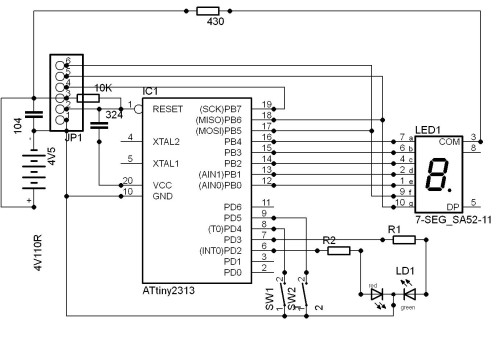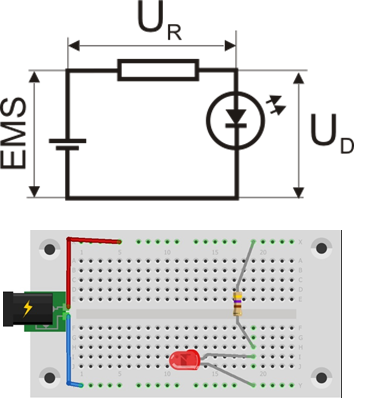
How to startup LED
LED (Light Emiting Diode) is a semiconductor element that emits light at the current flow. It's a current consumer and you have to keep it in mind. It is not important the voltage to which you are connecting but the current flowing through is. How to limit current, ie calculate serial resistance: If the EMS is source voltage,UR is voltage drop on the resistor and UD is a voltage drop on the diode. EMS = UR + UD UR = EMS - UD the current is constant so it can be written as: I × R = EMS - UD ... and finally what we need is the value of resistance: R = (EMS - UD)/I A Practical Example: We want to connect a red LED to a 5V (USB output on a computer) R = (5V -2V)/ 0,02A R =150 Ohm. It is not recommended to use the LEd diode at full power. Most of them were based on germanium so that the peak temperature was 90 ° C. Insert the 220 Ohm resistor and you will not even notice the difference in the intensity of the light. I = (EMS -UD) / R (do not run away from Ohm's law :)) I = (5 - 2)/ 220, I = 0,014A ili I=14mA It works great and very long.
2

Serial conection of LEDs and resistor
The most used LE diodes made for a current up to 20mA, which means that the serial resistor should be dimensioned to limit the current below the limit value, as I already said "less than 20mA". Characteristics of individual LED you will find on the net, so-called Datasheet. The voltage drop depends on the type and color of the LED. In principle it is about 1.5 to 4V.
For example: Standard1 20 mA LEDs (ranging from approximately 40 mW to 90 mW) at around: 1.9 to 2.1 V for red, orange, yellow, and traditional green 3.0 to 3.4 V for pure green and blue 2.9 to 4.2 V for violet, pink, purple and white
1.https://en.wikipedia.org/wiki/Light-emitting_diode
4
Serial connection of multiple LEDs
If we want to connect multiple LEDs to the same source we can do it in several ways: a) serial connection b) a parallel connection c) a combined connection
Serial connection of two or more LEDs
EMS = UR + ∑UD If you use LEDs of the same type they are:
EMS = UR + n×UD , where n is number of LEDs in serial conection. R1 = (EMS - n×UD) / I R1 = (12V - 4×2V)/0,02A R1 = (12-8V)/0,02A R1= 200 Ohma We used the first major, 220 Ohm. visit page: How much energy is released on this resistor: Typically, this is a small amount of heat that can withstand the most commonly used 1/4 Watt resistor. But check it out: P = U × I; P = 0.02 × 4V P = 0.08W.
5

Parallel connection of multiple LEDs
If we want to connect multiple LEDs in parallel then each of them must have their resistor, otherwise we will have uneven glow or even some will not light up in general. The parallel connection is only considered if the drive voltage is low because the energy losses here are very high.
Example: The resistance calculation is the same as in the first example
when we had one LED.
R = (EMS – UD) / I
If we connect to 5V
R = (5V -2V) / 0.02A
R = 150 Ohms.
R1 = R2 = R3 …
R = (EMS – UD) / I
If we connect to 5V
R = (5V -2V) / 0.02A
R = 150 Ohms.
R1 = R2 = R3 …
7

Published: Dec 7, 2017
Latest Revision: Dec 7, 2017
Ourboox Unique Identifier: OB-392406
Copyright © 2017








